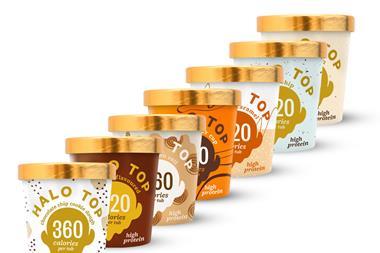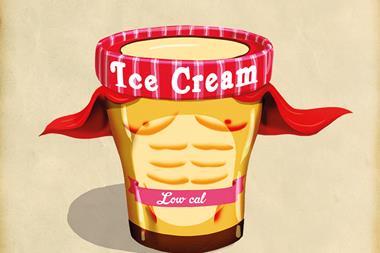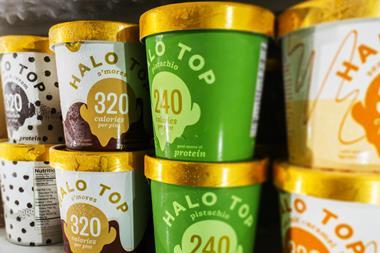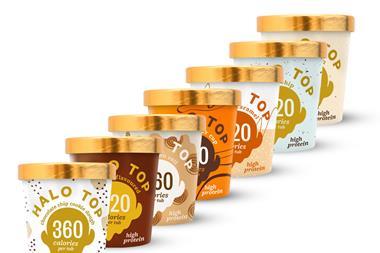
It’s reinvented indulgence as ‘healthy’, acquired a cult following through social media and turned the US ice cream market upside down.
Halo Top is one of the biggest disruptor stories in grocery right now - and it’s heading for the UK. As The Grocer revealed , the brand is looking to launch in British supermarkets in January.
So what will its impact be on the UK ice cream market?
At the heart of Halo Top’s success is permissibility - the idea that you can eat an entire pint of ice cream and still be ‘healthy’. All the brand’s ice creams come in at between 240 and 360 calories per pint, and the calorie count is flagged up on the front of pack. The range is also marketed as high in protein, containing about 20g per pint. By comparison, a 500ml tub of Ben & Jerry’s Phish Food has 15g of protein and comes in at a whopping 1,350 calories - a fact that Halo Top advertises prominently in an ‘us versus them’ section of its website.
Halo Top by numbers
Flavours : 25
Vegan variants : 7
Calories per pint : 240-360
Protein : 20g
US stores : 19,000
Revenue : $50m
3 year growth : 20,944%
Instagram followers : 593k
Facebook followers : 706k
Twitter followers : 34k
Pinterest followers : 11.5k
It’s a powerful message, says Alex Beckett, global food & drink analyst at Mintel.
“The combination of added protein, calorie count prominently displayed and shrewd use of social media struck a chord with young Americans, overturning the assumption health and nutrition didn’t have a place in the ice cream chiller.”
But to what extent will that message translate over here? No details are known about what Halo Top will offer in the UK: how many, if any, of its 25 US flavours will come over, whether its distinctive gold top packaging will stay, and how its stevia-based recipes might be adapted to suit British tastes.
Crucially, Halo Top’s use of social media and the David vs Goliath narrative of its marketing may be difficult to replicate. “It’ll be a challenge to repeat this word-of-mouth success here and the ice cream sector is a tough place for new brands to compete,” says Beckett.
Rapid growth
In the US, Halo Top has built up a 5% market share in a very short time and managed to dent the sales of category giants such as Unilever, which blamed the startup for its underperforming US ice cream business in its Q3 results earlier this month.
Such quick success has prompted a huge amount of media coverage, leading some industry voices to caution against over-hyping the potential impact of Halo Top on the UK market. “The effect of Halo Top on Unilever’s profits has been massively over-exaggerated by journalists Stateside,” says one UK ice cream source. “They are no worry to Unilever.”
Hype or no hype, the big brands are sure to be paying close attention. What will be playing in their favour is that, having seen Halo’s impact in the US, they’ll be better prepared to defend their market share in the UK.
“Unilever are unlikely to be blindsided in the same way from Halo Top’s entry into the UK, and we would expect a quicker response,” says Warren Ackerman, head of global staples research at Société Générale. “That said, we do see a low-calorie, high-protein ice cream offer also doing well in the UK but have some doubts as to whether it will do as well as in the US.”
Startups like Oppo, which has carved out a niche in the ‘healthy’ ice cream sector, will also be keeping a close watching brief. MD Charlie Thuillier says Halo Top’s entry proves healthy ice cream is “possible, mass market and very relevant to today’s consumer”.
And despite Halo Top’s track record, Thuillier is confident Oppo will hold its own. “Whilst the branding is good, Halo Top products contain table sugar and lack supplementary ingredients - unlike Oppo,” he says, pointing to his brand’s use of lucuma as opposed to caramelised sugar to deliver a salted caramel flavour.
The broader point to take from the Halo Top story is that disruption from small brands is now “the new normal” in grocery, says Thea Alexander, founder of the Young Foodies community for early-stage fmcg brands.
“Small brands, with no experience in the space and £20,000 in their pockets can cut through the market,” she says. “This is exactly what we’re seeing with Halo Top.”



















No comments yet